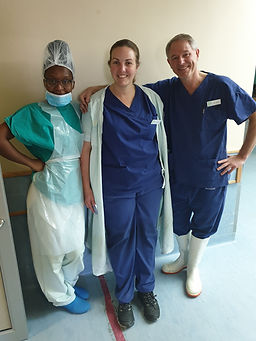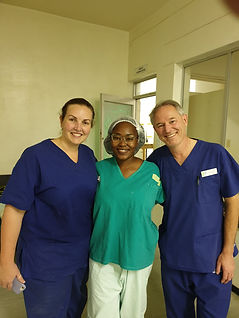Call us now on 08 9312 3055
Assoc. Professor Chris Gunnell
Dr Will Adams
Dr Danii Paterson
Ethiopia 2016
In July 2016 I spent the month working as a volunteer Obstetrician at a maternity hospital in a town called Barhirdar in Ethiopia. The hospital provides free maternity care to the poor. It is staffed by a group of 12 hand-picked and highly trained local midwives. Two volunteer doctors support these midwives; assisting with difficult medical/obstetric issues, complicated vaginal births and caesareans. You can check out a video of the hospital here
The hospital delivers between 150 and 210 babies a month. The facilities are basic but adequate. The women are all in a single 'Nightingale Ward' with very little privacy. There is no pain relief for women in labour but, if a caesarean is required, a spinal block is administered. The operating theatre is also very basic. One night, during a thunderstorm, the electricity went off while I was doing a caesarean. I had to continue the procedure under the light of my smartphone torch until the generator could be accessed and turned on! Despite the lack of resources, the death rate of babies in this institution is significantly less than other healthcare centres around the country and there have been no maternal deaths for three years. This is an incredible achievement and a testament to the untiring hard work of all the staff at the hospital.
Dr Andrew Browning is an Australian trained Gynaecologist who started his inspiring work in Africa as a fistula surgeon with the famous Hamlins in Addis Ababa. He went on to open his own fistula hospital in Barhirdar where he worked for several years. Realizing that prevention is better than cure, he then started up several maternity hospitals in Ethiopia (including Barhirdar) and Tanzania. You can find more information about these hospitals and the amazing work done by Maternity Africa here. If you are interested in supporting this worthwhile and inspiring charity, check out the Barbara May Foundation.









Ethiopia 2017
In November 2017 I returned to Barhirdar for another month. It was an amazing feeling to be greeted by the excited and familiar faces of the staff at the hospital. There is a constant turnover of obstetricians as visas to Ethiopia are only issued for one month at a time, so the staff love it when an ‘old face’ returns. I was welcomed as a friend and I’m sure the midwives were happy to not have to train me up!
The number of patients had grown since last I was there and the hospital was busier than ever. Several new local midwives had been employed to cope with the work. I quickly slotted back into the chaos. Luckily there was a fellow Australian obstetrician with me for most of the time to help take the pressure off.
It was a very exciting time to be in Barhirdar. A new hospital had been built from some very generous donations and it officially opened a week into my visit. I had the great privilege of being the first doctor to work in the new hospital! It was a major undertaking to move everything from the old tin shed hospital to the fancy new one and, of course, women continued to have babies in amongst the chaos. However, all went well, and we quickly settled into the new facility which has much more room and privacy for the women and staff.
Another highlight was a visit from Dr Andrew Browning. He came to check out the new hospital and I had the opportunity again to spend time with this inspiring but humble man. He was treated like royalty and the staff were on their best behaviour!
Settling into the new hospital did not always go smoothly. There were a few issues with the water supply and power. Once again, I found myself having to do a Caesarean during the night without any light! And the telephone system wasn’t fully functional. The midwives had to initially run back over to the old hospital to call me if there was an emergency. But all these issues slowly ironed themselves out over my time there and I left behind a wonderful new facility that will improve the quality of care for the fortunate women who find themselves having their baby in Barhirdar.
Stay tuned for the next instalment…….












Namibia 2019
In June 2019 I travelled to Oshakati in northern Namibia. This is a small town with a large regional general hospital covering a population of around one million. The hospital has a very busy maternity unit delivering around 8000 babies a year. There are currently no obstetricians in the hospital and the service is provided by midwives and junior doctors with little experience. The Head of Department is an amazing woman who is only 3 years out of medical school but has quickly learnt the skills to manage many of the complex clinical problems. There are also no specialist anaesthetists or paediatricians in the hospital. I went with a group of 8 colleagues - another obstetrician, 4 anaesthetists, an anaesthetic nurse and a neonatal intensive care nurse. Our role was to provide some intensive teaching and support to these junior doctors.
The hospital is basic but generally well equipped and most necessary medications are available. As in Ethiopia, the maternity ward is quite open with very little privacy. Women all labour together in the 1st stage room then walk around to the smaller (4 bed) 2nd stage room to birth their baby when they are fully dilated. There is no pain relief - epidurals are unheard of!
Many women in this part of Namibia (and those who come down from Angola) have lost babies. It is quite common for women to have had 8 to 10 children but lost 2 or 3; either during their pregnancy or as infants. There is a high incidence of HIV in the population and all women are screened during each of their pregnancies. Maternal death is also a sad reality in Namibia and very confronting to those of us fortunate enough to live in a country where childbirth is safe.
Initially the situation seemed overwhelming but we soon realized that a few small interventions could have a large impact. We taught basic surgical skills to junior doctors so that caesareans could be performed more efficiently and safely. Although not an ultrasound specialist, I was able to teach some simple ultrasound skills. Being able to more accurately date a pregnancy, measure a babies growth or check for twins or a low placenta on ultrasound can potentially save a mother and/or baby. The anaesthetists upskilled the doctors who performed spinals and general anaesthetics. We also did workshops on complicated obstetric problems, CPR and neonatal resuscitation.
Although only there for 2 weeks, hopefully we were able to provide enough support and education to potentially save a few lives in the future. A team will be returning 2 or 3 times each year from now so there will be ongoing help. We hope over time that the situation in Oshakati will reach a point where outside support is unnecessary.
If you want further information, wish to donate or feel that you may be able to contribute as a volunteer, please speak to me or visit www.healthvolunteers.org










